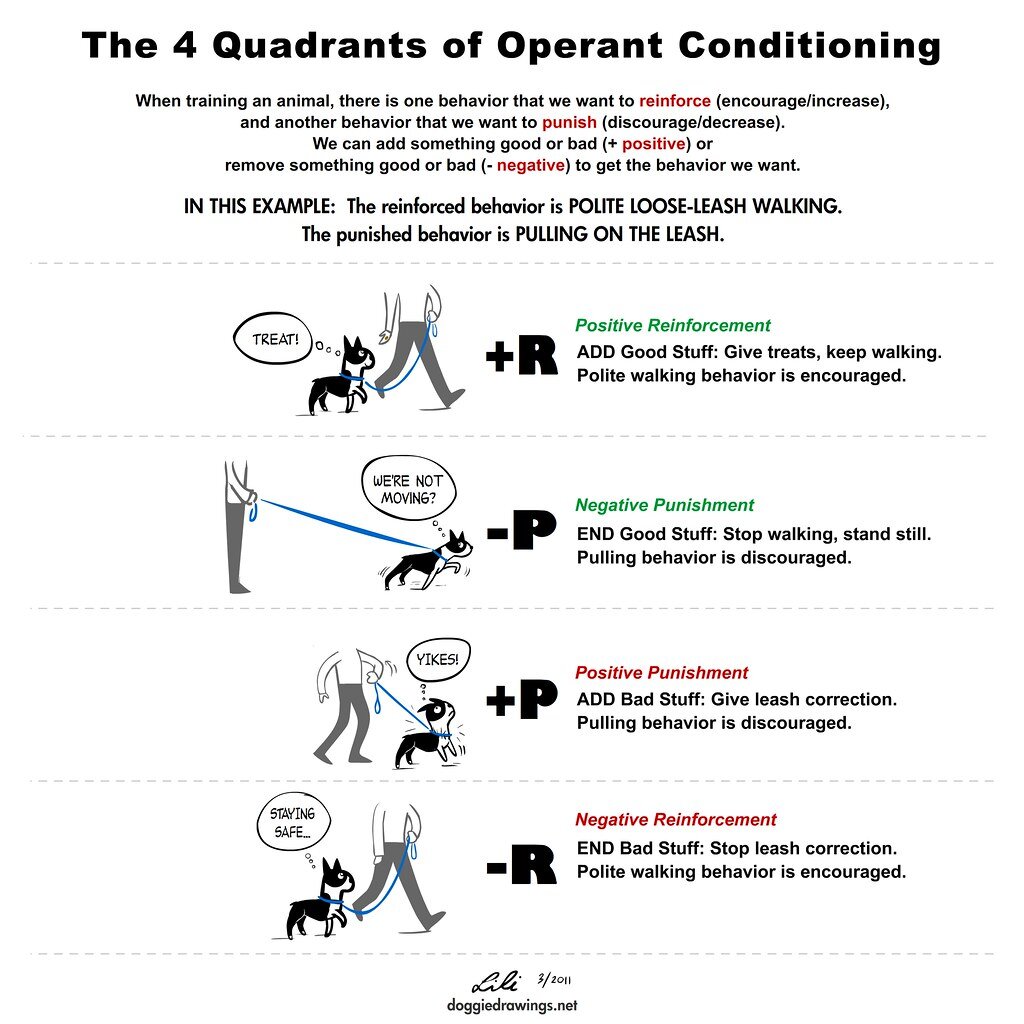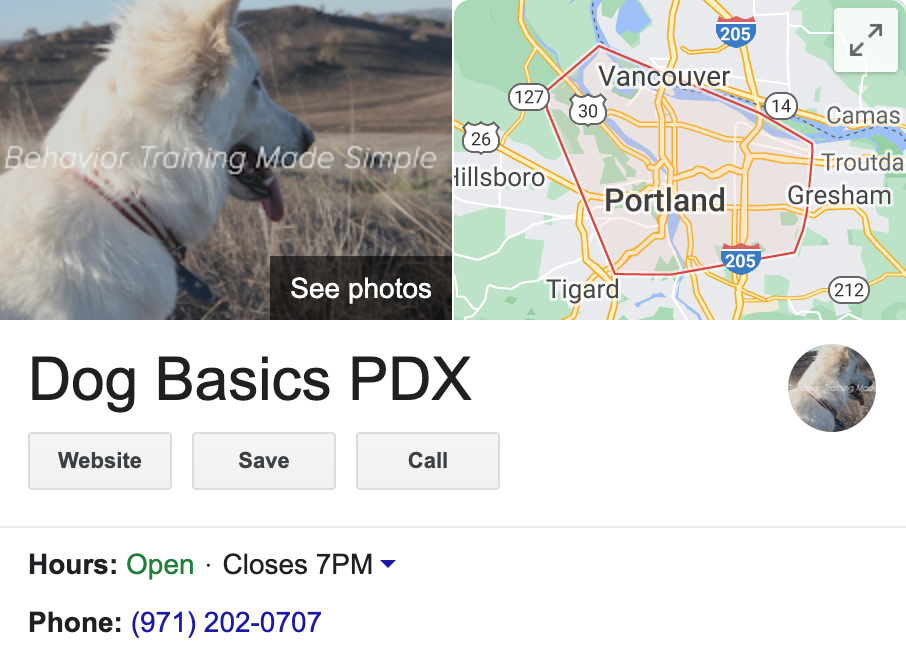Why +R?
Positive Reinforcement has received criticism by trainers who use force. It is sometimes called treat training. But treat training doesn’t explain the whole picture. Trainers who truly understand Positive Reinforcement, understand animal science and behavior. They are able to go on and take jobs working at zoo’s with elephants, tigers, whales, dolphins, and other wild animals where force based training would easily make these exotic animals run away. Veterinarian behaviorists rely on positive reinforcement in order to give vaccinations, perform routine checkups, grooming on elephants, lions, rhinos, and other species. Best of all positive reinforcement works for our best friends at home, dogs. If you’ve done ‘‘treat training’’ before and haven’t succeeded, it’s not the treats. It’s the lack of understanding of animal behavior.
Where to find trainers? Trainers who graduate from Karen Pryor Clicker Academy have to go through rigorous amounts of learning about animal science before they begin working with dogs. Veterinarian Behaviorist have to go through many years at a university before they attain their degree. Any Certified dog trainers from ccpdt.org also have to undergo rigorous exams to demonstrate humane, science based dog training.
You will often see dog walkers, hikers, dog boarding facilities offering training. If you’re looking for basics such as teaching a sit, it might not matter where you get your training. But if you’re looking for specialized focus on behavior aggression, fear, socialization, anxiety, leash pulling, it’s extremely important that you thoroughly ask your trainers where they have gained their experience and resources.
American Veterinary Society of Animal Behavior - Aversives damage secure base attachment to owner.
‘‘Dogs trained with aversive methods are more likely to have an insecure attachment, because the same has been found with children when positive punishment is used to discipline them.’’
Read more here: https://avsab.org/dog-training-methods-affect-attachment-to-the-owner/
PreventiveVet - Dog Training Aversives: What Are They And Why You Should Avoid them.
‘‘The bad behavior was never fixed, it was suppressed.’’
‘‘If your dog trainer relies on aversives, they are ignoring the most recent advances in behavioral science and are possibly too lazy to take advantage of more effective and humane training methods and tools.’’
Continue Reading Here: https://www.preventivevet.com/dogs/dog-training-aversives
Shock Collar Choke Chains!
Science has pushed animal science forward at a rapid pace. We no longer have to result to using tools invented in the 1970’s. MRI’s have been done on dog brains. There is an abundance amount of research on animal behavior. Trainers that still result to using Shock Collars or Choke Chains either have not caught up with the times, or are not skilled animal trainers. A good example is a teacher using a ruler in the classroom to show ‘‘Dominance’’ over the classroom. We are long pass those days. There’s a new way to build respect in the classroom, and that’s by creating safe learning environment by building relationships and nurturing curiousity. Away with the days of, ‘‘Straighten up or else!’’ (or in the dog world SIT or ELSE!)
Please tread with caution when seeing these phrases: ‘‘Balanced Trainer’’ ‘‘Must be comfortable with our training techniques’’ ‘‘E Collar Technologies’’ ‘‘Prong Collars’’ ‘‘Dominance’’ ‘‘Alpha Theory’’ ‘‘Pack Leader’’ ‘‘Shocks are just like tapping the dog on the shoulder (We think they mean throat)’’ ‘‘Corrections’’ ‘‘Popping the Collar’’ ‘‘Tighten the leash’' ‘‘Hold the leash tight’’
Many of these people are good at business and marketing and will also have ‘‘raving reviews’’ like this. Link to: This Shock Collar on Amazon has 5 Stars
Majority of our clients come to us after working with trainers and board & train facilities that promote methods of training that psychologically damage the dog.
Group Classes vs 1on1 Training
Group classes are a great way to train! But the advantages of one on one training is that even if you’re just doing basic obedience, you get 100% of our attention and full focus on your handling, technique, and body language, also of your own dogs quirks, behaviors, and reasoning why your dog is doing what he/she is doing for the full hour. This means that learning is extremely fast. In the course of one hour we were able to teach one dog 10 behaviors! (assuming your dog is a pup and ready to learn!). Whereas most classes teach basic obedience through a 6 week program. It does not take 6 weeks to teach sit, down, stay, focus. It takes this long because each dog and handler aren’t getting the attention that they need. Most people end up having to take the classes again because their dog (or the handler) didn’t get it the first time. You can avoid all this through getting the attention that you and your dog need 1 on 1 training. Does your dog already know basic obedience? We can move training to hikes on a trail, areas with plenty of dogs, and keep pushing your dog for growth. We are always pushing your dog to be the best that he/she can be. We have never had a client feel like they wasted money on a session. Every session is productive and we are always looking for your feedback to see where you would like to take it to the next level! No session is ever the same with all of our clients, it is unique to just you and your dog because we all progress and learn at different speeds.
What Does Training Look Like?
+ Reinforcement training looks like this. A lot different then punishment based training!
https://www.youtube.com/watch?v=tKLcA8j27BM
https://www.youtube.com/watch?v=gEkvxKDVBgM
https://www.youtube.com/watch?v=EUCl6ndLN7Q
https://www.youtube.com/watch?v=WWZUcLfHXLE
https://www.youtube.com/watch?v=vtRaoyRBV0Y
https://www.youtube.com/watch?v=CIaYMmBqTys
We are 100% Transparent. We would love for anybody who would like to come observe the way we work to come join us on our training sessions or at the ranch. Even if you don’t have a dog and you’re curious about animal training, we would love to teach you at no cost. Kids, teenagers, adults who are thinking about becoming dog trainers, send us a message! Let’s change the world one person, one dog, one family at at time.
I Can’t Afford Training
We will never turn a client down that is 110% willing to do anything to save their dog. Our goal is to decrease dogs from returning to shelters, changing multiple homes, or potentially leading to euthanization. Thanks to our current clients that help keep us on our feet, it gives us time and money to give back to our community. Please don’t hesitate to reach out to us. We will always be creative and find a solution together.
A Trainer Told Me My Dog Will Always Be Aggressive
We have had clients come to us saying, ‘‘A trainer told us that my dog will always be this way.’’ Because our background comes from working with Veterinarian Behaviorists, we should always rely on a 3rd party expert before you come to the conclusion that your dog will Always be like this. Some trainers don’t think outside of their own facility, and that is extremely dangerous and/or selfish. Modern medicine has come a long way to help with aggression, anxiety, food resource guarding, multiple dogs in household, etc. Before you listen to a trainer making a claim about your dog, seek a veterinarian behaviorist for their conclusion.
Treat Training Doesn’t work.
True positive reinforcement trainers (Karen Pryor Clicker Academy, SPCA, Humane Society’s) understand animal science and behavior. This is key in order to understand how to use +R to rid of aggression, leash pulling, fear, anxiety, and unwanted behaviors. The general population will copy videos on youtube, shows on netflix, and say that training doesn’t work. Which will result in, ‘‘treat training doesn’t work.’’ This is equivalent to people copying exercise workouts online and saying, ‘‘I didn’t lose any weight, or get stronger.’’
Similar to a physical trainers role, you have to have the skills to spot and understand where things are going wrong and where things are going right. Is it:
Motivation? (too lazy to go to the gym?) Is the dog motivated by food? by sniffing? by walking? When outside does the dog lose motivation for food?
Timing? Is it better to work out before or after dinner? before or after work? Does the dog like to be woken up to train, or right when I come through the door? Is the timing of my delivery fast enough to keep the dog engaged? Am I doing enough reps to build muscle?
Duration? Am I expecting myself to run or workout for too long that it feels more like a punishment? Is the dog having fun during training? Or am I Forcing/coercing the dog to cooperate.
Threshold? Am I way too stressed out to work out today? Is the dog way too stressed out to learn in his environment?
You can learn and see all of your blind spots when working beside a professional trainer.











